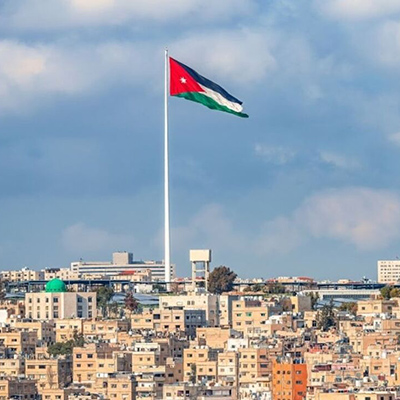Sites
Jordan
Written by: Mohsen Shirmuhammad,
Translated by: Hadi Qorbanyar
71 Views
Jordan is an Arab country that fully supported Iraq during the Iraq-Iran War and served as a key transit route for the delivery of weapons to Iraqi forces. Located in Western Asia, Jordan is bordered by Syria to the north, Iraq to the northeast, Saudi Arabia to the south and east, and the occupied Palestine to the west. The Gulf of Aqaba lies in the southwest of the country. Jordan has approximately 26 kilometers of coastline, and its capital is Amman. It is a semi-arid country, covering an area of 89,350 km.[1] Following World War I and the partition of the Ottoman Empire, Jordan became a British protectorate and gained independence in 1946, as the Kingdom of Jordan.[2]
Formal relations between Iran and Jordan date back to the Ottoman period, when Iran had a consular representation in Damascus. Following Jordan’s independence, Iran officially recognized the newly established state. On July 28, 1949, King Abdullah of Jordan visited Iran, and a Treaty of Amity was signed between the two countries on November 16 of the same year in Tehran. From that time until the victory of the Islamic Revolution in Iran, cordial relations existed between the two countries.[3]
After the Islamic Revolution, the Jordanian government recognized the Islamic Republic of Iran. King Hussein also sent a message congratulating Imam Khomeini (ra) on the success of the Islamic Revolution. On the first anniversary of the Revolution (February 1980), a ten-member delegation of prominent Jordanian scientific figures, headed by the Minister of Endowments and Islamic Affairs, visited Iran. Despite its formal expression of support for the Iranian Revolution, Jordan was concerned about the possible regional promotion of Iran’s revolutionary model.[4]
Following Iraq’s invasion of Iran on September 22, 1980, King Hussein of Jordan was the first leader to respond, publicly expressing support for Saddam Hussain on the next day, September 23.[5]
Proximity to Iraq, its shared road network, and the strategic port of Aqaba made Jordan a suitable transit corridor for transferring military equipment to Iraq. The closure of the Arvand Rud and the port of Basra on the one hand, and Iraq’s urgent need for various military supplies on the other, resulted in a large volume of military equipment being routed through Aqaba.[6] This trade also brought significant economic benefits to Jordan, turning Aqaba into a thriving commercial hub, and contributed to the development of the country’s road network and transport companies.[7]
King Hussein allowed Iraqi aircraft to use the H-5 Airbase[8] near the Iranian border for refueling. Iraqi fighter jets conducted training encounters in Jordanian airspace against Jordanian F-5s, which resembled the aircraft used by the Iranian Army. Iraq was also permitted to examine Jordan’s Hawk surface-to-air missiles, which were similar to those used by Iran. When Iraq received its first Mirage F1 jets from France, Jordan provided part of its own Mirage F1 fleet to Iraq. Ten of these aircraft, painted with Iraqi markings, participated in the war against Iran, and fifteen Jordanian pilots flew Iraqi Mirages during the conflict.[9]
In late 1980, Syrian President Hafez al-Assad accused Jordan of supporting the fundamentalist Muslim Brotherhood in its attempt to overthrow the Syrian government. Military mobilization along the shared border escalated tensions between the two countries, pushing their relations dangerously close to open conflict. Iran’s friendly ties with Syria, the deterioration of Jordan-Syria relations, and Jordan’s alignment with Iraq during the Iran-Iraq War[10] contributed to the severing of diplomatic relations between Iran and Jordan in 1981.[11]
After Operation Tariq al-Quds in November-December 1981, which forced Iraqi units to retreat from Iranian territory, King Hussein issued a statement urging Jordanians to volunteer for service alongside the Iraqi army in its war against Iran.[12] An organization called the Yarmouk Brigade was founded to oversee the deployment of Jordanian nationals to war zones.[13] Subsequently, the first group of Jordanian troops was deployed on March 2, 1982,[14] of whom six were captured by Iran and were released after the end of the war.[15] King Hussein also made a symbolic appearance on the northern front during the Iran–Iraq War, firing a 130-millimeter artillery piece towards Iranian territory alongside Saddam Hussain.[16]
Jordan also supported Iraq by providing secure exchange facilities and intelligence cooperation. Given to its close ties with Jordan during the eight-year war, Iraq gained access to sensitive intelligence on Iran and the wider region—collected by Western agencies such as the CIA—through its strategic cooperation with Amman. For instance, in 1982, William Casey, then head of the CIA, visited Jordan and met with Barzan, the head of Iraq’s intelligence service.[17] Due to the shortcomings of intelligence services in other Arab states and Iraq’s distrust towards them—combined with its close ties to Jordan—the Jordanian intelligence agency acted as Iraq’s primary intelligence partner.[18]
Jordan, being economically limited, could not provide substantial financial support to Iraq, but it offered full diplomatic backing. Moreover, since the United States did not have direct relations with Iraq at the time, King Hussein acted as an intermediary between Washington and Baghdad.[19]
On the international stage, Jordan also sought to influence various international forums to present Iraq as a peace-seeking state while portraying Iran as a threat to international peace and stability. A clear example of Jordan’s role was its tenure as the rotating president of the UN Security Council, during which resolutions 514, 522, and 540 were adopted, and Iran faced pressure to accept Resolution 598.[20]
After the end of the Iran-Iraq War, Jordan restored its diplomatic relations with Iran. The death of King Hussein in February 1999 did not significantly alter the relationship between the two countries. In fact, Amman-Tehran relations in the postwar years reflected the balance between two opposing factors. On the one hand, Jordanian officials expressed interest in expanding ties with Tehran; on the other, the United States pressured Amman to keep its distance from the Islamic Republic of Iran. Jordanian authorities have always tried to integrate both positions into their foreign policy framework.[21]
[1] Shirmuhammad, Mohsen, Sarbazi dar Keshvar-e Ordon (Military Service in the Country of Jordan), Mahname-ye Sarbaz, No. 294, Dey 1400, p. 42.
[2] Ibid., p. 42.
[3] Arzyabi-ye Monasebat-e Iran va Ordon (Assessment of Iran–Jordan Relations), Moassese-ye Motaleat va Pazhuhesh-haye Siyasi, 4 Tir 1400, www.psri.ir
[4] Ibid.
[5] Razoux, Pierre, Jang-e Iran va Araq (The Iran-Iraq War), Trans. Abdolhamid Heydari va Ali Ahmadi, Tehran, Marz-o-Boom, 1397, p. 204.
[6] Koushki, Muhammad-Sadeq va Seyyed Morteza Arizi Meybodi, Barrasi-ye Sazokar-e Eqdamat-e Nezami, Ettelaati va Siyasi-ye Dolat-e Ordon dar Poshtibani az Rezhim-e Saddam Te-ye Jang-e Hasht-Saleh Alayh-e Iran (Analysis of Jordan’s Military, Intelligence, and Political Support for Saddam’s Regime during the Eight-Year War against Iran), Faslname-ye Elmi-ye Motaleat-e Defa Muqaddas, No. 22, Tabestan 1399, p. 84.
[7] Razoux, Pierre, Ibid., p. 205.
[8] Ibid., p. 204.
[9] Ibid., p. 205.
[10] Muhammadpour, Muhammad, Mavaze va Hemayat-haye Siyasi-ye Ordon az Araq dar Jang-e Tahmili (Jordan’s Political Positions and Support for Iraq during the Imposed War), Dow Faslname-ye Motaleat-e Enqelab-e Eslami va Defa Muqaddas, No. 2, Paeiz va Zemestan 1396, p. 122.
[11] Lotfollahzadegan, Ali-Reza, Roozshomar-e Jang-e Iran va Araq, Ketab-e Bistom: Oboor az Marz (Chronology of the Iran-Iraq War, Book 20: Crossing the Border), Tehran, Markaz-e Motaleat va Tahqiqat-e Jang-e Sepah-e Pasdaran, 1381, p. 297.
[12] Alaei, Hussain, Ravand-e Jang-e Iran va Araq (The Course of the Iran-Iraq War), Vol. 1, Tehran, Marz-o-Boom, 1391, p. 400.
[13] Kodam Keshvar-e Arabi Avalin Hami-ye Araq dar Jang ba Iran Boud (Which Arab Country Was Iraq’s First Supporter in the War against Iran?), Khabargozari-ye Tasnim, 15 Tir 1393, www.tasnimnews.com/fa/news/1393/04/15/423246
[14] Koushki, Muhammad-Sadeq va Seyyed Morteza Arizi Meybodi, Ibid., p. 86.
[15] Aqaei Jirandeh, Abbas va Fatemeh Rostami, Pa be Pay-e Azadegan (Side by Side with the Freed Prisoners of War), Tehran, Markaz-e Asnad-e Enqelab-e Eslami, 1386, Pp. 105–106.
[16] King Hussein Shah-e Ordon ba Toop-e 130 be Sooye Iran Shelik Kard (King Hussein of Jordan Fired a 130mm Cannon towards Iran), Khabargozari-ye Fars, 5 Mehr 1387, www.farsnews.ir/news/8707050769
[17] Koushki, Muhammad-Sadeq va Seyyed Morteza Arizi Meybodi, Ibid., p. 82.
[18] Ibid., p. 83.
[19] Razoux, Pierre, Ibid., p. 204.
[20] Muhammadpour, Muhammad, Ibid., p. 144.
[21] Arzyabi-ye Monasebat-e Iran va Ordon (Assessment of Iran–Jordan Relations), Moassese-ye Motaleat va Pazhuhesh-haye Siyasi, 4 Tir 1400, www.psri.ir





